The Safety of Transnational Imported Second-Hand Cars: A Case Study on Vehicle-to-Vehicle Crashes in Romania
Abstract
:1. Introduction
2. Materials and Methods
2.1. The Study Area and Database
2.1.1. Crash Database
2.1.2. Registered Vehicles Database
2.1.3. RHD Vehicles Database
2.2. Methods
2.2.1. Statistical Approach
2.2.2. GIS Approach
3. Results and Discussion
3.1. Importation of Vehicles in Romania 2008–2015
3.2. Car Crashes in Romania 2008–2015
3.3. Regression and Pearson Correlation Analysis of the Relation between Importation of Second-Hand Cars and Traffic Safety
3.4. Right-Hand Driving Cars Involved in Traffic Accidents
4. Conclusions
Acknowledgments
Author Contributions
Conflicts of Interest
References
- Ciobanu, S.M.; Benedek, J. Spatial characteristics and public health consequences of road traffic injuries in Romania. Environ. Eng. Manag. J. 2015, 14, 2689–2702. [Google Scholar]
- Benedek, J.; Ciobanu, S.M.; Man, T.C. Hotspots and social background of urban traffic crashes: A case study in Cluj-Napoca (Romania). Accid. Anal. Prev. 2016, 87, 117–126. [Google Scholar] [CrossRef] [PubMed]
- Chu, T.; Delgado, A. Used Vehicle Imports Impact on New Vehicle Sales: The Mexican Case. Anál. Econ. 2009, 24, 347–364. [Google Scholar]
- European Commission. Consumer Market Study on the Functioning of the Market for Second-Hand Cars from a Consumer Perspective; European Commission: Brussels, Belgium, 2014; ISBN 978-92-79-45692-3. [Google Scholar]
- Cosciug, A. Transnational Motorways. The secondhand car trade in a country of emigration. Anthropol. News 2017, 58, e338–e342. [Google Scholar] [CrossRef]
- Dobler, G. From Scotch Whisky to Chinese Sneakers: International Commodity Flows and New Trade Networks in Oshikango, Namibia. Africa 2008, 78, 410–432. [Google Scholar] [CrossRef]
- Obeng-Odoom, F. Drive left, look right: The political economy of urban transport in Ghana. Int. J. Urban Sustain. Dev. 2010, 1, 33–48. [Google Scholar] [CrossRef]
- Cooper, P.J.; Meckle, W.; Osborn, J. Estimating the effect of the vehicle model year on crash and injury involvement. J. Autom. Eng. 2010, 224, 1527–1539. [Google Scholar] [CrossRef]
- Broughton, J. Car driver casualty rates in Great Britain by type of car. Accid. Anal. Prev. 2008, 40, 1543–1552. [Google Scholar] [CrossRef] [PubMed]
- Cuerden, R.; Edwards, M.J.; Pittman, M.B. Effect of Vehicle Defects in Road Accidents. Available online: https://www.ewu.edu/Documents/CBPA/NWTTAP/Newsletter/Publications/PPR565.pdf (accessed on 18 November 2017).
- Torrão, G.A.; Coelho, M.C.; Rouphail, N.M. Effect of vehicle characteristics on crash severity: Portuguese experience. Inj. Prev. 2012, 18, 310–316. [Google Scholar] [CrossRef]
- Bédard, M.; Guyatt, G.H.; Stones, M.J.; Hirdes, J.P. The independent contribution of driver, crash, and vehicle characteristics to driver fatalities. Accid. Anal. Prev. 2002, 34, 717–727. [Google Scholar] [CrossRef]
- Farmer, C.M.; Lund, A.K. Trends over time in the risk of driver death: What if vehicle designs had not improved? Traffic Inj. Prev. 2006, 7, 335–342. [Google Scholar] [CrossRef] [PubMed]
- Lécuyer, J.F.; Chouinard, A.; Transport Canada. Study on the Effect of Vehicle Age and the Importation of Vehicles 15 Years and Older on the Number of Fatalities, Serious Injuries and Collisions in Canada. In Proceedings of the Canadian Multidisciplinary Road Safety Conference XVI, Winnipeg, MB, Canada, 11–14 June 2006. [Google Scholar]
- Vrkljan, B.H.; Anaby, D. What vehicle features are considered important when buying an automobile? An examination of driver preferences by age and gender. J. Saf. Res. 2011, 42, 61–65. [Google Scholar] [CrossRef] [PubMed]
- Akloweg, Y.; Hayshi, Y.; Kato, H. The effect of used cars on African road traffic accidents: A case study of Addis Ababa, Ethiopia. Int. J. Urban Sci. 2011, 15, 61–69. [Google Scholar] [CrossRef]
- Cooper, P.J.; Meckle, W.; Nasvadi, G. The safety of vehicles imported from right-hand-drive vehicle configuration countries when operated in a left-hand-drive vehicle environment. Accid. Anal. Prev. 2009, 41, 108–114. [Google Scholar] [CrossRef] [PubMed]
- Bari, M.M. The study of the possibility of switching driving side in Rwanda. Eur. Transp. Res. Rev. 2014, 6, 439–453. [Google Scholar] [CrossRef]
- National Institute of Statistics, Romania—INS 2015. Available online: www.insse.ro (accessed on 18 November 2017).
- Ivan, K.; Haidu, I.; Benedek, J.; Ciobanu, S.M. Identification of traffic accident risk-prone areas under low-light conditions. Nat. Hazards Earth Syst. Sci. 2015, 15, 2059–2068. [Google Scholar] [CrossRef]
- Alian, S.; Baker, R.G.V.; Wood, S. Rural casualty crashes on the Kings Highway: A new approach for road safety studies. Accid. Anal. Prev. 2016, 95, 8–19. [Google Scholar] [CrossRef] [PubMed]
- Dai, D. Identifying clusters and risk factors of injuries in pedestrian-vehicle crashes in a GIS environment. J. Transp. Geogr. 2012, 24, 206–214. [Google Scholar] [CrossRef]
- Steenberghen, T.; Aerts, K.; Thomas, I. Spatial clustering of events on a network. J. Transp. Geogr. 2010, 18, 411–418. [Google Scholar] [CrossRef]
- Stutts, J.C.; Hunter, W.W. Motor vehicle and roadway factors in pedestrian and bicyclist injuries: An examination based on emergency department data. Accid. Anal. Prev. 1999, 31, 505–514. [Google Scholar] [CrossRef]
- Economic and Social Council, United Nations. Consolidated Resolution on the Construction of Vehicles (R.E.3). Available online: http://www.unece.org/fileadmin/DAM/trans/doc/2014/wp29/ECE-TRANS-WP29-2014-052e.pdf (accessed on 18 November 2017).
- Truong, L.T.; Kieu, L.M.; Vu, T.A. Spatiotemporal and random parameter panel data models of traffic crash fatalities in Vietnam. Accid. Anal. Prev. 2016, 94, 153–161. [Google Scholar] [CrossRef] [PubMed]
- Freund, R.; Wilson, W. Regression Analysis: Statistical Modeling of a Response Variable; Academic Press: San Diego, CA, USA, 1998; ISBN 0122674758. [Google Scholar]
- Mohamed Salleh, F.H.; Arif, S.M.; Zainudin, S.; Firdaus-Raih, M. Reconstructing gene regulatory networks from knock-out data using Gaussian Noise Model and Pearson Correlation Coefficient. Comput. Biol. Chem. 2015, 59, 3–14. [Google Scholar] [CrossRef] [PubMed]
- Lee, J.; Wong, D.W.S. Statistical Analysis with ArcView GIS; John Wiley and Sons: New York, NY, USA, 2001; ISBN 0-471-34874-0. [Google Scholar]
- Durduran, S.S. A decision making system to automatic recognize of traffic accidents on the basis of a GIS platform. Expert Syst. Appl. 2010, 37, 7729–7736. [Google Scholar] [CrossRef]
- Gundogdu, I.B. Applying linear analysis methods to GIS-supported procedures for preventing traffic accidents: Case study of Konya. Saf. Sci. 2010, 48, 763–769. [Google Scholar] [CrossRef]
- Li, Y.; Kim, A.M.; El-Basyouny, K.; Li, R. Using GIS to interpret automated speed enforcement guidelines and guide deployment decisions in mobile photo enforcement programs. Transp. Res. Part A Policy Pract. 2016, 86, 141–158. [Google Scholar] [CrossRef]
- Rodrigues, D.S.; Ribeiro, P.J.G.; da Silva Nogueira, I.C. Safety classification using GIS in decision-making process to define priority road interventions. J. Transp. Geogr. 2015, 43, 101–110. [Google Scholar] [CrossRef]
- Carter, J.; Piza, E. Spatiotemporal convergence of crime and vehicle crash hotspots: Additional consideration for policing places. Crime Delinq. 2017, 1–25. [Google Scholar] [CrossRef]
- Smith, M.; Goodchild, M.; Longley, P. Geospatial Analysis—A Comprehensive Guide to Principles, Techniques and Software Tools, 5th ed.; Troubador Publishing Ltd.: Kibworth Beauchamp, UK, 2015. [Google Scholar]
- Brooks, A. Networks of power and corruption: The trade of Japanese used cars to Mozambique. Geogr. J. 2012, 178, 80–92. [Google Scholar] [CrossRef]
- Brooks, A. Stretching global production networks: The international second-hand clothing trade. Geoforum 2013, 44, 10–22. [Google Scholar] [CrossRef]
- Clerides, S. Gains from trade in used goods: Evidence from automobiles. J. Int. Econ. 2008, 76, 322–336. [Google Scholar] [CrossRef]
- Nieuwenhuis, P.; Beresford, A.; Choi, K.Y. Shipping air ? Tracking and forecasting the global shipments of of new and used cars. J. Marit. Res. 2007, 4, 17–36. [Google Scholar]
- Root, E. The Impact of Used Car Imports on the Industry and Markets in Eastern Europe. In Proceedings of the Global Automotive Conference, Florence, Italy, 11 May 2006. [Google Scholar]
- Rosenfeld, M. Mobility and social capital among Lebanese and Beninese entrepreneurs engaged in transnational trade. Int. Rev. Sociol. 2012, 22, 211–228. [Google Scholar] [CrossRef]
- Judgment of the Court (Grand Chamber). Available online: http://curia.europa.eu/juris/document/document.jsf?text=&docid=163660&pageIndex=0&doclang=RO&mode=req&dir=&occ=first&part=1&cid=264553 (accessed on 18 November 2017).
- Marinescu, N.; Istrate, I. Car Taxation in the European Union: The Case of Romania. Int. J. Arts Sci. 2009, 3, 83–94. [Google Scholar]
- Sandu, D. Modernising Romanian society through temporary work abroad. In A Continent Moving West?: EU Enlargement and Labour Migration from Central and Eastern Europe; Black, R., Engbersen, G., Marek Okólski, C.P., Eds.; Amsterdam University Press: Amsterdam, The Netherlands, 2010; pp. 249–271. ISBN 978-90-8964-156-4. [Google Scholar]
- Anghel, R.G.; Botezat, A.; Coșciug, A.; Manafi, I.; Roman, M. International Migration, Return Migration, and Their Effects: A Comprehensive Review on the Romanian Case. IZA DP 2016, 1–49. Available online: https://ssrn.com/abstract=2895293 (accessed on 18 November 2017).
- Beuving, J. American cars in Cotonou: Culture in African entrepreneurship and the making of a globalising trade. J. Modern Afr. Stud. 2015, 53, 317–338. [Google Scholar] [CrossRef]
- Chalfin, B. Cars, the customs service, and sumptuary rule in neoliberal Ghana. Comp. Stud. Soc. Hist. 2008, 50, 424–453. [Google Scholar] [CrossRef]
- Smith, L. Tied to migrants. In Transnational Influences on the Economy of Accra, Ghana; African Studies Centre: Leiden, The Netherlands, 2007; pp. 1–256. ISBN 978-90-5448-074-7. [Google Scholar]
- European Commission. Trends, statistics and main challenges. In Road Safety in the European Union; European Commission: Brussels, Belgium, 2015; pp. 5–23. ISBN 978-92-79-45654-1. [Google Scholar]
- Bambach, M.R.; Mitchell, R.J. Estimating the human recovery costs of seriously injured road crash casualties. Accid. Anal. Prev. 2015, 85, 177–185. [Google Scholar] [CrossRef] [PubMed]
- Balch, A.; Balabanova, E. Ethics, Politics and Migration: Public Debates on the Free Movement of Romanians and Bulgarians in the UK, 2006–2013. Politics 2014, 36, 19–35. [Google Scholar] [CrossRef]
- Fox, J.E.; Morosanu, L.; Szilassy, E. The racialization of the new European migration to the UK. Sociology 2012, 46, 680–695. [Google Scholar] [CrossRef]
- Moroşanu, L. Professional Bridges: Migrants Ties with Natives and Occupational Advancement. Sociology 2016, 50, 349–365. [Google Scholar] [CrossRef]
- Rolfe, H.; Fic, T.; Lalani, M.; Roman, M.; Prohaska, M. Potential impacts on the UK of future migration from Bulgaria and Romania. Natl. Inst. Econ. Rev. 2013, 224, 1–4. [Google Scholar] [CrossRef]
- Cosciug, A. The role of social capital in the development of trade with second-hand cars in Central and Eastern Europe, The case of Romania and Moldova. Moldosc. Probl. Anal. Polit. 2016, 1, 102–120. [Google Scholar]
- Mehlhart, G.; Merz, C.; Akkermans, L.; Jordal-Jørgensen, J. European Second Hand Car Market Analysis; Final Report; Öko-Institut e.V.: Breisgau, Germany, 2011; pp. 4–163. [Google Scholar]
- Centre for Automotive Management. The Used Car Market Report 2012; BCA: Bergisch Gladbach, Germany, 2012; pp. 3–96. [Google Scholar]
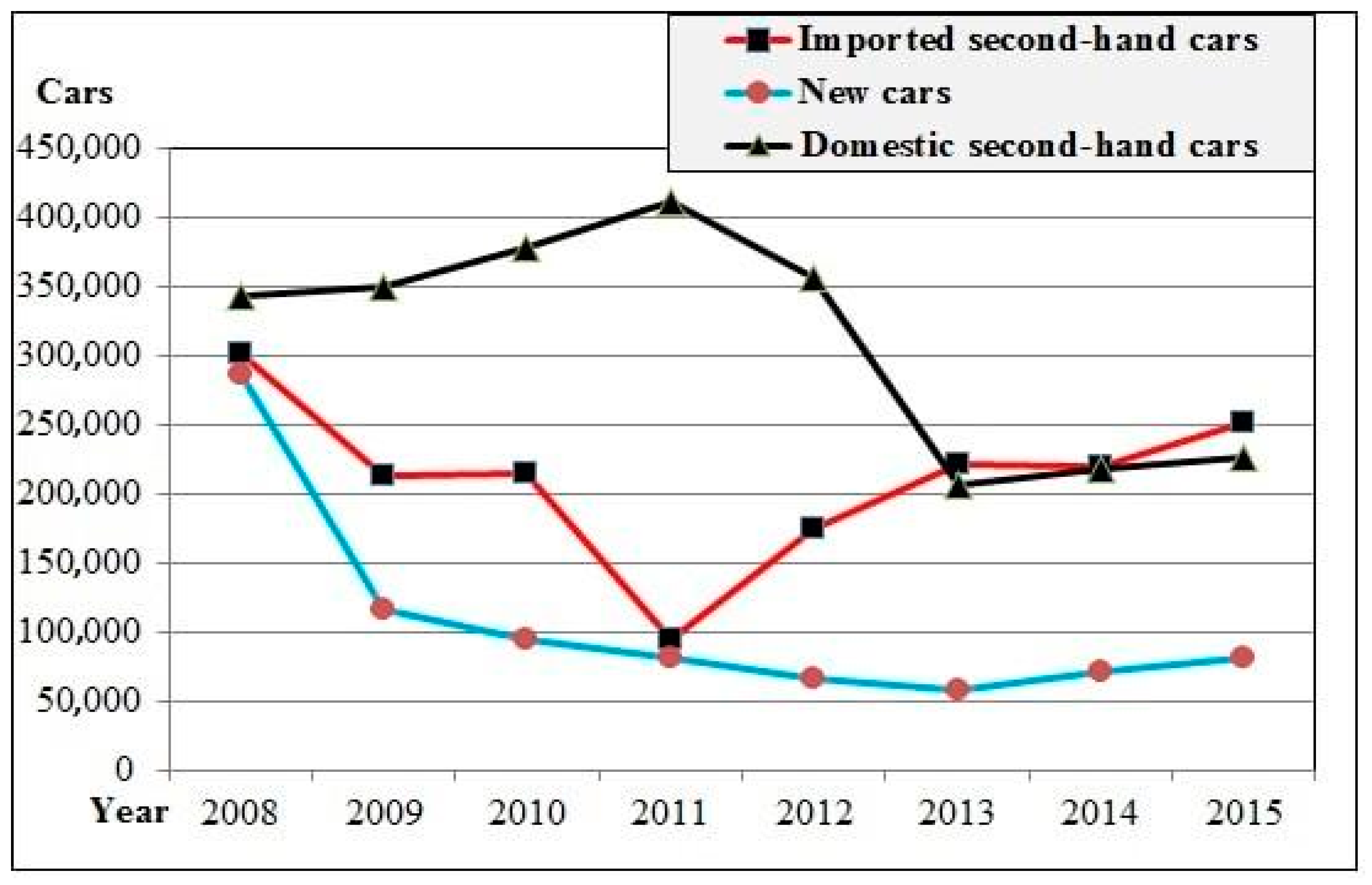
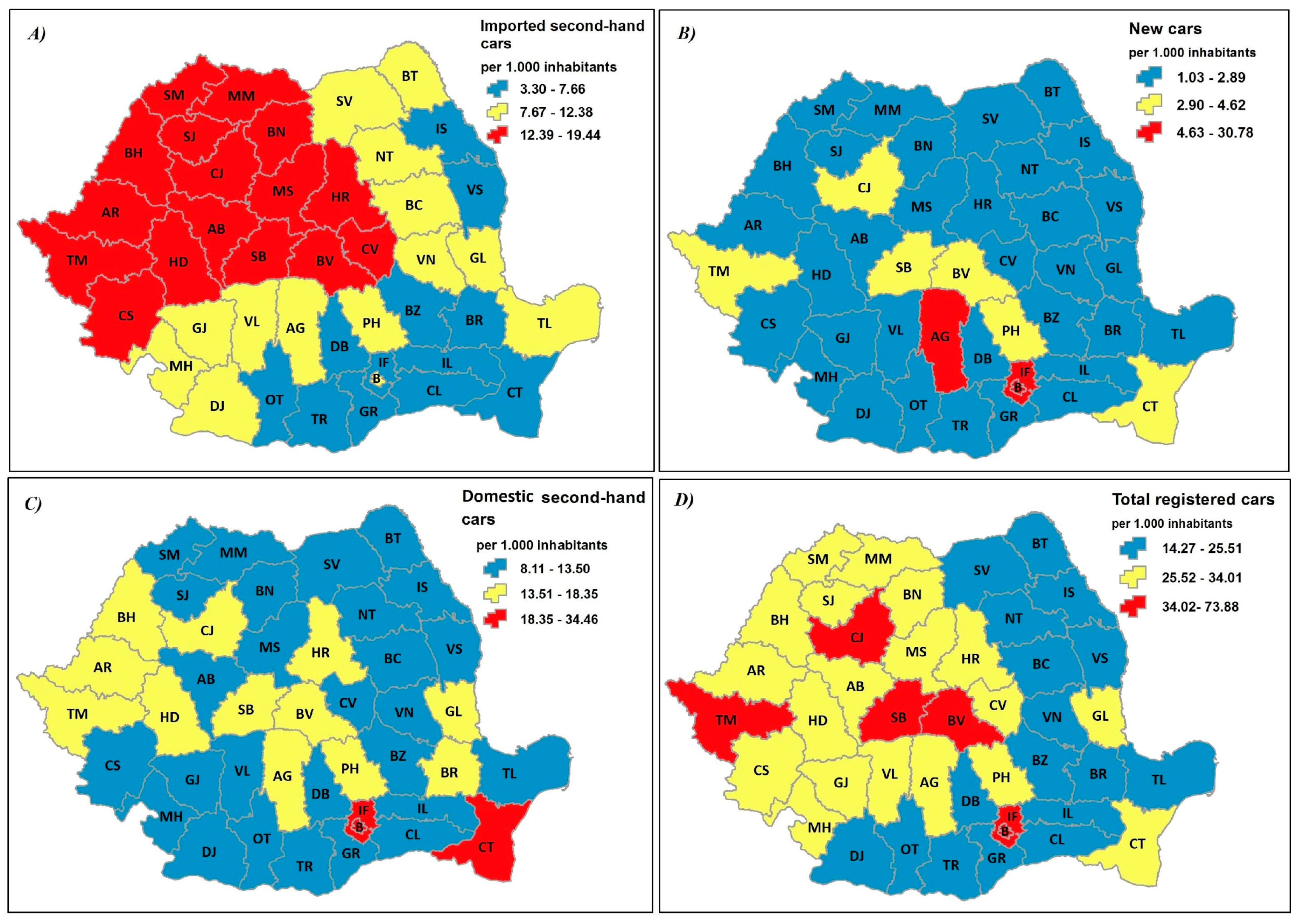
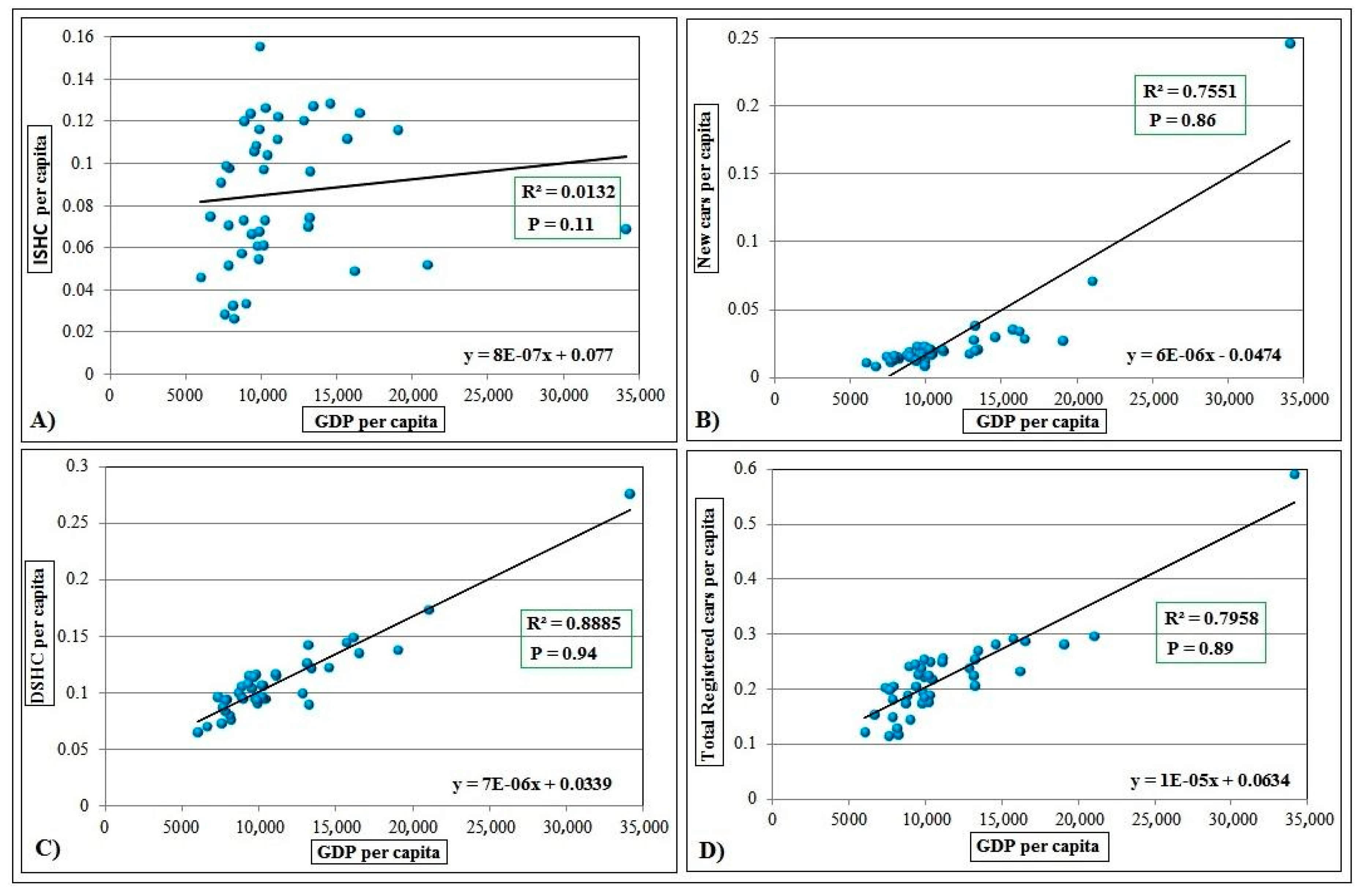

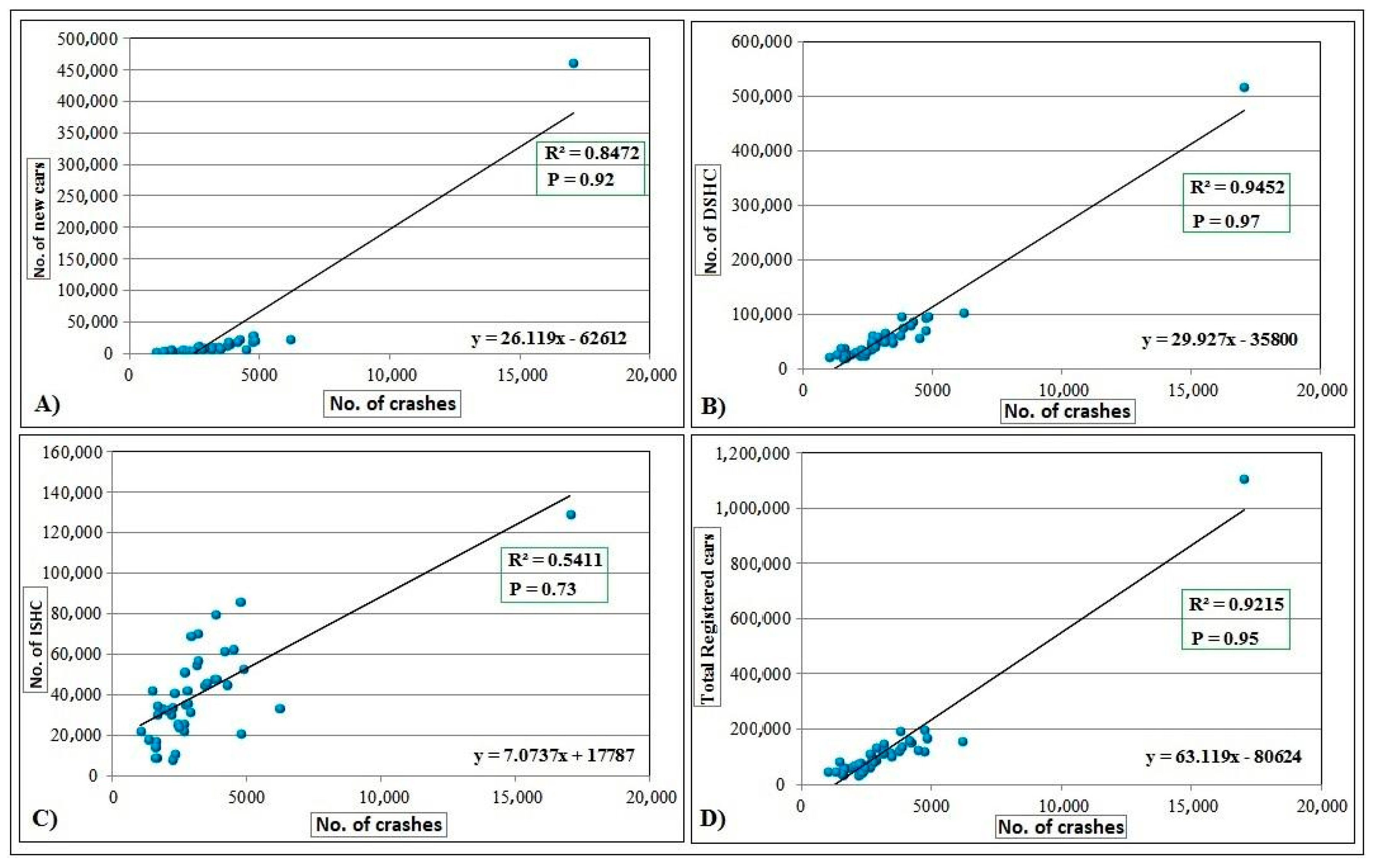
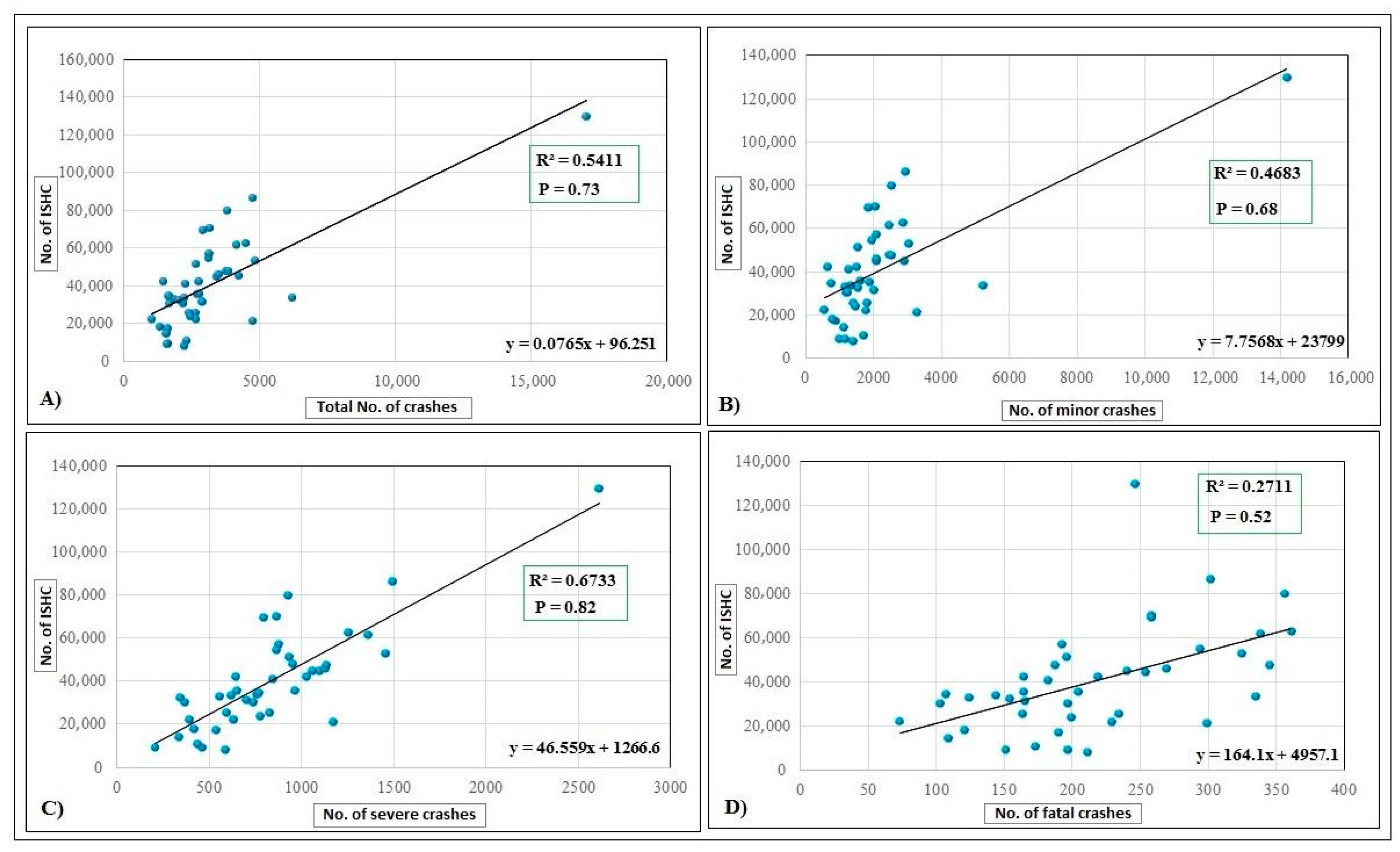

| Year | Crashes | Vehicles | Minor | Severe | Fatal | Total Casualties | Fatalities Per 1 mil. Inhabitants |
|---|---|---|---|---|---|---|---|
| 2008 | 18,847 | 31,551 | 20,117 | 6240 | 2028 | 28,385 | 98 |
| 2009 | 18,001 | 30,403 | 19,235 | 6011 | 1791 | 27,037 | 88 |
| 2010 | 16,097 | 27,518 | 17,269 | 5592 | 1472 | 24,333 | 73 |
| 2011 | 16,483 | 28,174 | 17,802 | 5665 | 1225 | 24,692 | 61 |
| 2012 | 16,482 | 28,166 | 18,282 | 5691 | 1234 | 25,207 | 60 |
| 2013 | 14,987 | 26,011 | 16,637 | 5206 | 1078 | 22,921 | 54 |
| 2014 | 15,065 | 26,390 | 17,118 | 5093 | 1085 | 23,296 | 54 |
| 2015 | 17,389 | 30,665 | 19,649 | 5717 | 1159 | 26,525 | 58 |
| Total | 133,351 | 205,127 | 146,109 | 39,599 | 11,072 | 202,396 | 69 * |
© 2017 by the authors. Licensee MDPI, Basel, Switzerland. This article is an open access article distributed under the terms and conditions of the Creative Commons Attribution (CC BY) license (http://creativecommons.org/licenses/by/4.0/).
Share and Cite
Coșciug, A.; Ciobanu, S.M.; Benedek, J. The Safety of Transnational Imported Second-Hand Cars: A Case Study on Vehicle-to-Vehicle Crashes in Romania. Sustainability 2017, 9, 2380. https://doi.org/10.3390/su9122380
Coșciug A, Ciobanu SM, Benedek J. The Safety of Transnational Imported Second-Hand Cars: A Case Study on Vehicle-to-Vehicle Crashes in Romania. Sustainability. 2017; 9(12):2380. https://doi.org/10.3390/su9122380
Chicago/Turabian StyleCoșciug, Anatolie, Silviu Marian Ciobanu, and József Benedek. 2017. "The Safety of Transnational Imported Second-Hand Cars: A Case Study on Vehicle-to-Vehicle Crashes in Romania" Sustainability 9, no. 12: 2380. https://doi.org/10.3390/su9122380





